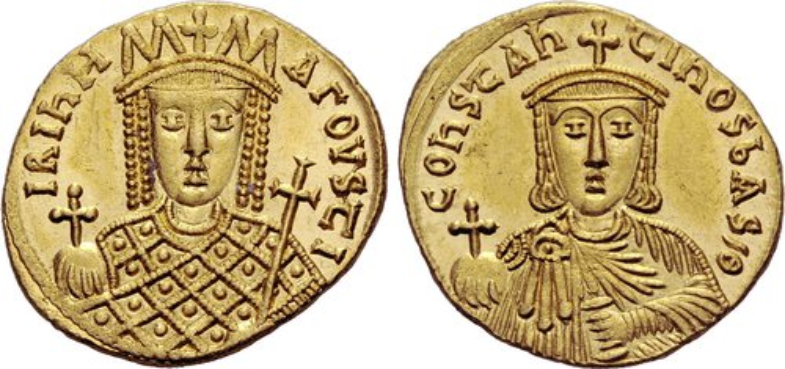
Irene of Athens was the first Roman empress to rule in her own right as regent, between 797 and 802 AD. Although she ruled solely for only five years, she left a lasting impact on the foreign policy and religious practices of the Eastern Roman (Byzantine) Empire.
Irene’s significant policy was ending iconoclasm, which divided the Eastern Roman Empire between iconoclasts and iconophiles from 726 to 787 AD. She supported the iconophiles, who believed in the veneration of religious icons, leaving a lasting impact on Greek Orthodox Christianity.
However, Irene is mostly remembered for the lengths to which she went to maintain her authority, going as far as having her own son, Constantine VI, blinded, deposed, and thrown in prison so that she could seize power for herself and become the first Roman empress to rule as sole regent.
Irene of Athens: Not a typical Roman empress
Irene was born in Athens sometime between 750 and 756 AD, at which point the city was a part of the Greek-speaking Eastern Roman (Byzantine) Empire. In November 769 AD, she married the heir to the Eastern Roman throne, Leo IV in the capital, Constantinople. Her coronation took place in the following month.
In 771 AD, Irene gave birth to a son, Constantine VI. Her husband, Leo IV died in 780, leaving Constantine as the heir to the throne. However, he was only nine years old when his father died and Irene ruled as regent.
Only six weeks after the death of her husband, conspirators were already plotting to depose Empress Irene and replace her with Caesar Nikephoros, a half-brother of Leo IV. The Roman Empress caught wind of the plot and forced the conspirators to take up positions in the Church which barred them from political office.
According to the scholarly work of historian Lynda Garland, Irene exercised more power than was typical of a Roman empress. For example, the imperial coinage issued during this period depicted Irene and her son Constantine as equal co-rulers, not as regent and emperor which would have been the pre-established norm.
The blinding of Constantine VI
The expectation would have been for Empress Irene to relinquish most of her political power as her son Constantine matured and eventually came of age as there was not a precedent for sole female rule in the Eastern Roman Empire at this time.
Despite these expectations, Irene did all she could to stay in power, which ultimately led to a showdown between mother and son.
Constantine’s initial attempts to wrestle power for his mother were unsuccessful and Irene henceforth demanded that oaths of imperial loyalty should be sworn in her name alone. In 790 AD, some members of the army proclaimed Constantine as the sole emperor, but he ultimately lacked enough political support to permanently sideline his mother.
Two years later, Constantine was forced to reconcile with his mother and restored her titles, and recognized her as co-ruler. However, Empress Irene worked together with her network of influential supporters to undermine Constantine and he was eventually forced to flee the capital and seek allies in the provinces.
Constantine was captured in 797 AD and brought back to Constantinople. Irene then had her own son blinded in prison, finally removing the threat to her continued authority. It is not certain when Constantine died, but he ceased to be a political threat to his mother.
However, Empress Irene had other enemies. In 802 AD, she was deposed by patricians opposed to her rule and replaced with Nikephoros who had served as the minister of finance. Her fate was less cruel than that imposed on her son. She was forced into exile on the Greek island of Lesbos where she sustained herself by spinning wool until she died a year later.
Iconoclasm
Irene of Athens’ lasting legacy is heavily colored by the political contest with her son, but this level of familial political intrigue is hardly out of the ordinary in the grand scheme of Roman/Byzantine history. From a historical point of view, her impact on religious practices within the empire was more consequential.
Although Irene’s husband, Leo IV, was an iconoclast, the Empress herself harbored iconophile tendencies.
Iconoclasm in the Eastern Roman Empire refers to two distinct periods of religious controversy in the 8th and 9th centuries, during which the use and veneration of religious icons were banned and the icons destroyed. The iconoclasts believed that the veneration of icons violated the Ten Commandments by promoting idolatry, while the iconophiles defended the use of icons as aids to worship and spiritual connection.
Ultimately, Irene reversed the iconoclast policy of her husband, Leo IV, and actively supported the restoration of the veneration of icons. In 787, she convened the Second Council of Nicaea, which affirmed the legitimacy of icons and condemned iconoclasm as heretical. Irene’s actions contributed to the eventual end of the first period of iconoclasm and the restoration of the use and veneration of icons in the Byzantine Empire.
See all the latest news from Greece and the world at Greekreporter.com. Contact our newsroom to report an update or send your story, photos and videos. Follow GR on Google News and subscribe here to our daily email!



